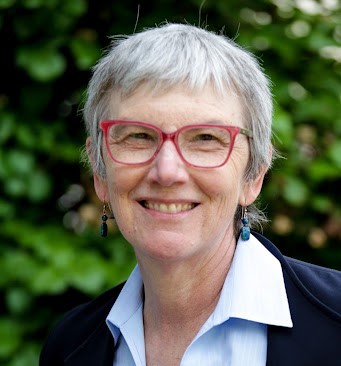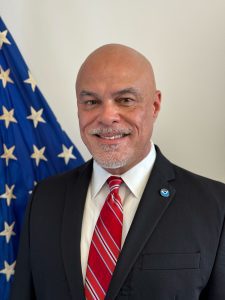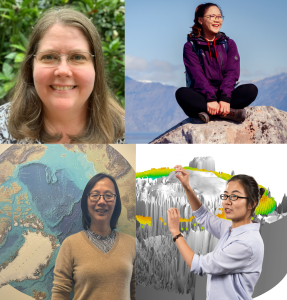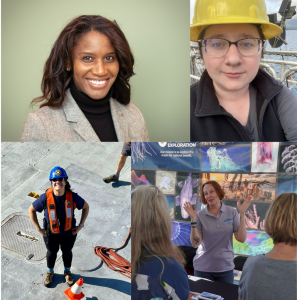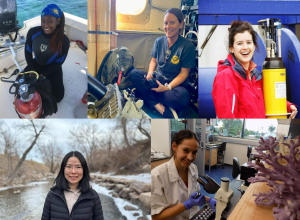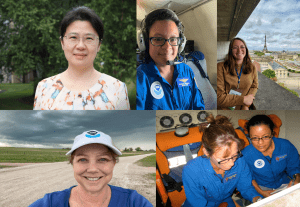Margaret Lansing is a communications specialist overseeing the Information Services Branch at the NOAA Great Lakes Environmental Research Laboratory in Ann Arbor, Michigan. She started working for NOAA in 1988 as a student intern and soon segued to a permanent position doing bench chemistry and field work in the Great Lakes, the Gulf of Mexico, and even Yellowstone Lake. Mid-career, she transitioned to science communications.
What drew you to your current career or field?
As a child, whenever I went to a park, a beach, or a museum and saw people working there I thought they had the most amazing jobs in the world. They seemed to know so much. I really admired them and, quite honestly, I was rather taken with their uniforms. I wanted a shirt or hat with a cool logo and to be a part of something important. I guess that explains in part why I pretty much live in my NOAA logo wear these days.
I also loved my science classes and watching nature programs. NOAA didn’t exist yet when I was coming of age but if it had I’m quite sure it would have been my dream agency. It’s certainly been a dream job to be able to spend my career working with people focused on understanding our oceans, coasts, and Great Lakes. I feel particularly fortunate because I spent the first half of my career doing hands-on research “to understand and predict…..” and now I focus on the “to share that knowledge and information with others” part of the NOAA mission.


What projects or research are you working on now?
One exciting new initiative I am working on is the NOAA partnership with Viking Expeditions in the Great Lakes. This is a new public-private collaboration that will draw global attention to NOAA’s research and programs serving the Great Lakes region. I am helping to shape the science programming that the Viking guests will experience. The very first Great Lakes cruises start this spring so we are on a fast track.
Another favorite current project is updating the food web infographics for the Great Lakes. This is an inter-agency team effort, and I’m one of many but I guess you could call me the head wrangler or perhaps the champion cat herder. These food web diagram posters are a very popular product with school teachers and are among the most popular pdf downloads on our website. It feels good to translate our technical understanding of the food web into something that is accessible to young people and the general public.
What do you enjoy most about your work?
I thrive in a team environment and truly enjoy teamwork. I’m involved and lead a number of teams and am so grateful to be working together to deliver meaningful products to our stakeholders. Working in communications is great for people like me who love immediate gratification. You can write a story or post something on social media and it’s immediately shareable. Earlier in my career I did a lot of lab work running a variety of equipment. My favorite was isolating gases on a high vacuum cryogenic distillation line and then running samples on our stable isotope mass spectrometer. The lab was visually interesting because we used dry ice, liquid nitrogen, and sealed off ampules with a blow torch. I became a frequent tour stop for VIP guests because I loved engaging with them and sharing our research. I now take pride in helping our scientists to tell the stories of their research.


Do you have a favorite moment or accomplishment in your career?
Over the years I participated in many visits to Congressional offices both on Capitol Hill and in Great Lakes district offices. As a communicator about NOAA products and programs, this was a special and obviously important audience to share information with. It was a lot of planning and then both exhilarating and exhausting to suit up and crisscross Capitol Hill to the Senate and House buildings and converse directly with Congressional members and their staff.
Other than that I have so many favorite memories of field work on research vessels that are mostly about being together in an intense work environment for days or weeks at a time. One particularly exciting opportunity was participating on a number of research dives in the Johnson-Sea-Link II submersible in Lake Superior. Living and working together in amazing locations was rewarding, exhausting and fun. Looking back I see it as an absolute privilege to have been a part of that.
Who do you look to as a role model and why?
In grammar school and in high school I had some great teachers. My high school biology teacher saw something in me and was pretty direct with me about focusing and applying myself. She demanded the best from all her students and for the first time I learned what it meant to really push myself, create my own standards and develop an internal compass. Fast forward to today; I draw inspiration from a wide variety of what I guess I would call everyday people. For my work life, my role models are mostly colleagues and peers at GLERL and the Cooperative Institute for Great Lakes Research (CIGLR). Especially since COVID, I watch them balance their work and personal lives. In spite of all the challenges they continue to dig in and deliver. When I see others doing that it motivates and inspires me to do the same.
Looking back, what would you tell yourself when you were 12 years old? Or what advice would you give to a woman just starting out in her career?
In general I would say become aware of and utilize your resources. For early career women (everyone really) I would suggest taking a look at the federal training opportunities and taking advantage of them, there are so many available. For folks working in the field offices, I recommend finding a way to spend time at NOAA Headquarters or another Line Office to get a sense of greater NOAA. Having the big picture provides you with a fuller appreciation of your place in NOAA and in the world.
